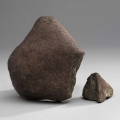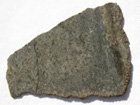ROM research on meteorite by Dr. Kim Tait solves age old
Martian puzzle
 (Toronto, Ontario – July 24, 2013) In a major discovery released in the scientific journal Nature, Royal Ontario Museum curator Dr. Kim Tait and colleagues have solved an age old riddle in geologic history of Mars. The study involved a Martian meteorite, from the ROM’s collection, named NWA 5298. It was found that this space rock started as a 200 million-year-old lava flow on Mars. This conclusion has settled a long standing debate about the age of this type of Martian meteorite and indicates that at least some of the Martian surface is young – by geologic standards. Full details can be found in the paper titled, “Solving the Martian meteorite age conundrum using micro-baddeleyite and launch-generated zircon."
(Toronto, Ontario – July 24, 2013) In a major discovery released in the scientific journal Nature, Royal Ontario Museum curator Dr. Kim Tait and colleagues have solved an age old riddle in geologic history of Mars. The study involved a Martian meteorite, from the ROM’s collection, named NWA 5298. It was found that this space rock started as a 200 million-year-old lava flow on Mars. This conclusion has settled a long standing debate about the age of this type of Martian meteorite and indicates that at least some of the Martian surface is young – by geologic standards. Full details can be found in the paper titled, “Solving the Martian meteorite age conundrum using micro-baddeleyite and launch-generated zircon."
The team conducted geochronogical testing on tiny crystals found in NWA 5298 by examining the precise composition of these crystals.
“With the ROM’s capacity and expertise in the field of Martian meteorites, research carried out on NWA 5298 was a timely opportunity for The Museum’s Mineralogy department to further expand our expertise and to collaborate with international colleagues. Through this study published in Nature, we have unlocked an important key towards understanding the application of geochronology and of the Red Planet itself,” said Dr. Kim Tait, ROM Curator, Mineralogy.
With the team’s research findings, Tait and her colleagues provide a much clearer picture of the Red Planet's evolution that can now be compared to that of the Earth and other rocky planets in our Solar System and beyond.
The team, comprised of scientists from the ROM, the University of Western Ontario, the University of Wyoming, University of California, Los Angeles, and the University of Portsmouth, also discovered crystals that grew while the meteorite was launched from Mars towards Earth. This discovery, allows them to narrow down the timing to less than 20 million years ago while also identifying possible launch locations on the flanks of the supervolcanoes at the Martian equator.
Discovered in March of 2008 in Northwest Africa, and acquired by the ROM in 2009, NWA 5298 is a part of the ROM’s meteorite collection; one of the largest in the world.
New Acquisition:
 This newly released research based on NWA 5298 coincides with the confirmed acquisition of the newest addition to the ROM’s mineralogy collection. Known as NWA 7042, this meteorite is also a Martian meteorite found in Northwest Africa, and an important new addition to the Museum’s Mineralogy department.
This newly released research based on NWA 5298 coincides with the confirmed acquisition of the newest addition to the ROM’s mineralogy collection. Known as NWA 7042, this meteorite is also a Martian meteorite found in Northwest Africa, and an important new addition to the Museum’s Mineralogy department.
NWA 7042 is the fourth largest single mass shergottite in existence and the fifth largest among all known Martian meteors. Shergottites are similar to basaltic rocks found on Earth. It is also one of about only 70 distinct Martian meteorites that have been confirmed.
Weighing 2.98 kilograms, NWA 7042 will be the centre piece of the ROM’s already impressive display of meteorites from the Red Planet and will enhance the ROM’s visitor experience. The remarkable NWA 7042 specimen is now the 15th Martian meteorite in the Museum’s collection, placing the ROM alongside Washington D.C.’s Smithsonian Institution, and the National Institute for Polar Research in Japan, in terms of total numbers of Martian main masses (the largest piece of a given meteorite). NWA 7042, along with NWA 5298 and the many other main masses of Martian meteorites at the ROM, are another important contribution towards ROM research. This acquisition was made possible thanks to funding from the Louise Hawley Stone Trust.
ROM visitors can view these Martian rocks as part of a collection which is currently on display in the Teck Suite of Galleries: Earth's Treasures on Level 2 of the Weston Family Wing for a limited time.
“I am excited about securing the NWA 7042 as part of the ROM’s Martian meteorite collection,” said Tait. “This is important for us in ROM Mineralogy toward our continued study of Mars itself and the solar system at large, as well as providing an advanced understanding of Martian formation and evolution of Mars.”
At present, the ROM’s Earth Sciences section is involved in a number of groundbreaking studies focused on Mars. These include providing critical samples of Martian meteorites which will help to interpret scientific data, as collected by the Mars rover Curiosity. Curiosity saw a significant contribution of Canadian support and scientific expertise by way of design, piloting and research.
*Interviews and images available upon request
